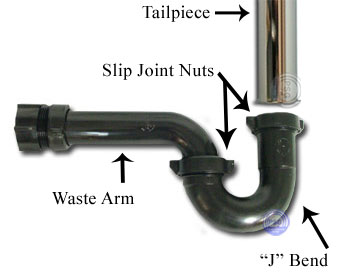It's common for a household sink to get clogged up, and sometimes this means you will need to remove the trap under the sink to remove the debris. In a just a few easy steps you can have your sink draining properly in no time.
First, a few tips to try before removing your drain:
- First, run some very hot water down the drain in an attempt to clear blockage
- If that does not work, try using a plunger in the sink - push down slowly, then pull up quickly
- If these do not work, it's time to remove the drain
Tools you will need to remove the drain:
Bucket, wrench or channel lock pliers, rags, cleaning brush, masking or duct tape.
Step 1:
First, locate the drain trap under your sink. The pieces you will most commonly see under your sink are: a tailpiece, slip joint nuts, a "J" shaped trap ("J" bend), a waste arm and a section of pipe coming from the wall. Together, these pieces are commonly referred to as a "P-trap".

Step 2:
Place a bucket or dish pan under the trap to catch any water that might come out as the trap is being removed.
Step 3:
Unscrew the slip joint nuts on each side of the "J" section of the trap. You may be able to do this by hand, but if your plumbing is older, it is likely you will need to use channel lock pliers or a wrench to loosen them. If you have a metal or decorative finish on your trap, use a strap wrench to prevent scratching the finish. Or, you can use masking or duct tape on the inside of your pliers to prevent scratching the finish. Another method would be to place a rag over the slip joint nuts before using the pliers or wrench, so that the tool does not come in contact with the metal finish.
Step 4:
Once the slip joint nuts are loose, continue to untighten them by hand and remove the trap. Remember to have your bucket handy! This is where it can get messy as there is usually water in the bend of the "J".
Step 5:
With the trap removed, you will notice that in between the slip joint nut and trap there is an o-ring. Be sure to put these in a safe place as they are very necessary to seal the connection. Also, note the order these parts are in: the slip joint nut will go onto the tail piece then the o-ring, then the threaded trap end (same for the side connecting to the wall).
Step 6:
You can stuff a rag into the pipe coming from the wall to prevent any sewer gases from coming up into your home.
Step 7:
Use a bottle brush or other cleaning tool to remove any debris found in the trap. You can also gently clean the tailpiece coming from the sink, and slightly into the pipe in the wall to remove any "gunk" that may be present. It's also not a bad idea to take the trap to another sink and rinse it out, this will remove any left over soap scum or residue that could contribute to another clog in the future.
Step 8:
With all the parts cleaned up you can now begin to reassemble the trap. Again, noting the order the parts are installed: the slip joint nut will go onto the tail piece or wall pipe, then the o-ring, then the threaded trap end.
Step 9:
Hand-tighten the slip joint nuts until tight. Use your wrench or pliers to tighten a quarter turn more. Be careful of two things: Do not cross thread and do not over tighten! Plastic traps, especially, will crack if over tightened.
Tips:
- Some traps have a cleanout plug on the bottom of the bend. To clean these types of traps, simply unscrew the plug and use a stiff wire to snag and remove the clog. Be sure to have a bucket under the drain because there will be water in the bottom of the trap.
- Some find it helpful to place a towel, or piece of masking tape over the sink and/or faucet to remind themselves and others not to use the sink while unassembled.
- We do not recommend pouring unsafe, dangerous to your health (and sometimes your pipes), bad for the environment, products into your drain to clear up blockages. Physical removal of hair and other debris is best. The regular use of a safe product such as Roebic K-67 can help prevent slow drains and stoppages.
- Unfortunately, there really is no substitute for manually removing a hair clog. Chemicals used to remove hair clogs are often inefficient and often result in manually removing the clog anyway. Not to mention how harmful they are. If you find that a lot of hair goes down the drain in your household, you may consider purchasing a stainless steel mesh strainer for your lavatory, tub or shower. These strainers are an inexpensive, easy to clean way to help keep your drain from clogging with hair so frequently.
- The above steps can be useful not only for unclogging your sink, but to retrieve items dropped down the drain.
